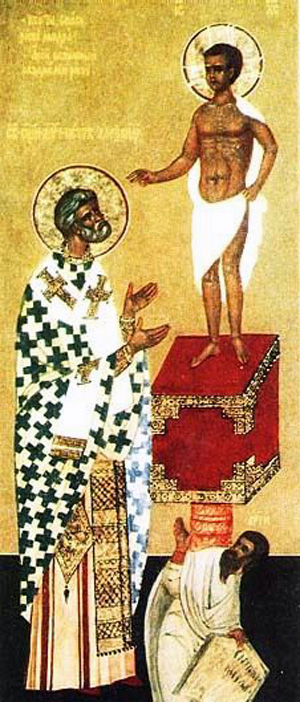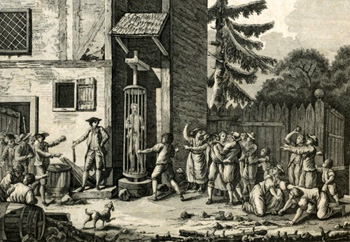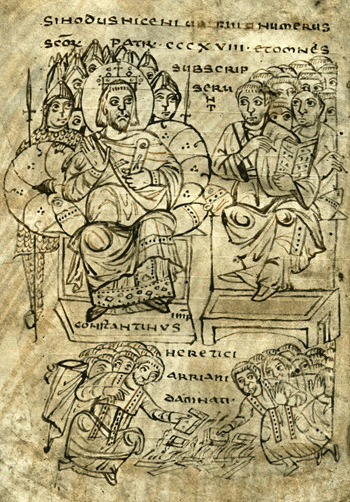 |
The Saint of the Day
St. Peter of Alexandria – November 26
Prof. Plinio Corrêa de Oliveira
Biographical selection:
First: St. Peter was Bishop of Alexandria (300-311) at the time of the persecutions of Diocletian and Maximinus Daia. When the first persecution started, he established penances for those Catholics who had made concessions to their persecutors to save their lives. These were Catholics who had become intimidated and committed the abomination of burning incense to the idols. Afterwards, in despair, they turned to the Church to ask forgiveness.
St. Peter of Alexandria composed a set of rules establishing penances for those who had lapsed so that they could make reparation for their infamous actions and be re-admitted to the faith.
To the lapsed who had suffered prison and sustained torture but afterwards gave up the Faith, he declared that 40 days of fasting were necessary for them to be purged. To those who had suffered in prison without torture but had made concessions, he prescribed one year of penance.

The Child warns the Bishop not to pardon Arius |
To those who had suffered none of these things but had deserted from fear only and timidity, he declared that the parable of the sterile fig tree would suit them. If, after three years they should show good fruits, labors making them worthy of penitence, then they should be assisted. But those who remained impenitent or despairing should suffer the fate of the cursed fig tree, which was cut down and thrown away.
Second: After Peter of Alexandria had been apprehended and cast into prison, Arius became fearful that the Saint would die without giving him absolution. He asked, then, for principal members of the clergy to intercede for him before the Bishop. Those priests went to visit St. Peter in the prison.
After the customary oration, they prostrated themselves before him, and with groans and tears while kissing his hands, they implored him, saying: “Most blessed father, by the excellence of your faith, the Lord is calling you to receive the martyr's crown. Therefore, do you not think it is right that, with your accustomed piety, you should pardon Arius, and extend your indulgence to his lamentations?”
The man of God, moved by indignation, raising his hands to Heaven, exclaimed: “Do you dare to supplicate me on behalf of Arius? Both here and in the next world, Arius is forever banished and separate from the glory of the Son of God, Jesus Christ our Lord.”
Struck with terror, the priests were silent, realizing that the Bishop gave forth such a sentence against Arius by divine inspiration.
In fact, St. Peter later took aside Fr. Alexander, his companion in prison, and told him the reason for his severity:
“The hidden treachery of Arius surpasses all iniquity and impiety. What I said, I did not assert of my own self. For last night, while I was solemnly pouring forth my prayers to God and you were sleeping, a Boy of about 12 years, the brightness of whose face I could not endure, appeared to me in this cell, making it radiant with an intense light. He was clothed with a linen tunic torn into two parts, from the neck to the feet.
“At this vision I was stupefied with astonishment. When I could make bold to speak, I exclaimed: ‘Lord, who has rent your tunic thus?’
“He answered me: ‘Arius has rent it.’ And he added: ‘By all means beware of receiving him into communion; for tomorrow priests will come to intercede for him. See, therefore, that you not be persuaded to acquiesce. Rather, tell Aquillas and Alexander the priests, who will be your successors and will rule My church, not by any means to receive him. As for you, you shall very quickly fulfill the lot of the martyr.’”
Comments of Prof. Plinio:
Regarding the first part of this selection, you can see the types of extremely severe penances the Church applied in times past. Those penances had a beautiful side, which is that all of them opened the way to pardon. Excepting only those who refused to repent, for all the others the road of pardon was opened.

Above, a pillory cage for public shaming in Regensburg; below, medieval German shame masks for transgressions of gossip, lies and ‘piggish’ acts
 |
This was a time when there were public penances, not just private penances. When someone would give public scandal, in order to be readmitted to the Sacraments, he had to suffer a public shame that corresponded to the evil he had done. In this way public morality was redressed by those penances.
If you imagine this custom continuing into our times, you can realize the salutary character this law would have. So, if this practice were still applied today, we would have the case of a movie star who lived a scandalous life by acting in immoral films and then wanted to return to the Sacraments.
Well and good, she would be received with all kindness; but, before being re-admitted to the faith, she would have to read publically in all the churches of the Diocese where she resides a request for forgiveness to God and to all those she scandalized by the evil she had done. Thus, the offended public dignity is restored and the great offense to the glory of God is repaired.
This was in the time when the civil laws had also infamous penalties for crimes. For example, when a man and a woman were caught in adultery, they were rolled in glue and afterward covered with the feathers of ducks and chickens. In this ridiculous state the couple was obliged a walk through the central streets of the village where they lived. Young ruffians would not lose the opportunity to follow the couple, mocking them and throwing rotten fruit and vegetables at them.
After that humiliation, the guilty parties would return to their homes or move to another village in order to not be obliged to face the public scorn for their sin. With this type of punishment, public morality was redressed. In such conditions, a pardon did not signify an act of weakness, but a genuine act of goodness.
When this kind of public redress was simultaneously practiced by the Church and society, public morality had the force to punish all those who committed scandals.
Today things are very different. Someone sins, the others say: “O, poor man, let us forgive him. After all there were these attenuating factors...” More, they say, "woe to those who judge him, who speak evil of him, or who throw the first stone."
That is to say, those who represent public morality receive all the stones that should be directed at the scandalous ones. You can see how this is wrong and, thus, understand the value of the public penances the Church gave.

Constantine ordered the burning of all Arius' writings as heretical while Arius was still living
|
Regarding the second part of the selection, you see that St. Peter of Alexandria was imprisoned and that there was an effort being made to induce him to forgive Arius before his martyrdom. Obviously, Arius desired that forgiveness with an evil intent. He did not have any good intent to reform or any real contrition. He was planning to make bad use of that pardon to once again fool those who remained faithful and to drag a larger number of them with him to perdition.
Then, to prevent that evil from happening, on the night before the visit of the priests, St. Peter received an apparition. The Child Jesus appeared to St. Peter of Alexandria with His tunic torn down the middle into two parts to show him what Arius had done to His Church, symbolized by His rent tunic.
The Child told St. Peter: “Neither you nor your successors should receive Arius.” Further, He stated that for Arius there was no more forgiveness. The evil he had done was so great that there was no more pardon for him. Here you see how far Divine Severity can go even with a person who is still living.
Let us close asking St. Peter of Alexandria to give us both the discernment he received of those who are evil and the love for rigorous penances that he established.


  |
|
Prof. Plinio Corrêa de Oliveira | |
The Saint of the Day features highlights from the lives of saints based on comments made by the late Prof. Plinio Corrêa de Oliveira. Following the example of St. John Bosco who used to make similar talks for the boys of his College, each evening it was Prof. Plinio’s custom to make a short commentary on the lives of the next day’s saint in a meeting for youth in order to encourage them in the practice of virtue and love for the Catholic Church. TIA thought that its readers could profit from these valuable commentaries.
The texts of both the biographical data and the comments come from personal notes taken by Atila S. Guimarães from 1964 to 1995. Given the fact that the source is a personal notebook, it is possible that at times the biographic notes transcribed here will not rigorously follow the original text read by Prof. Plinio. The commentaries have also been adapted and translated for TIA’s site.
|
Saint of the Day | Home | Books | CDs | Search | Contact Us | Donate

© 2002- Tradition in Action, Inc. All Rights Reserved
|
 |

|